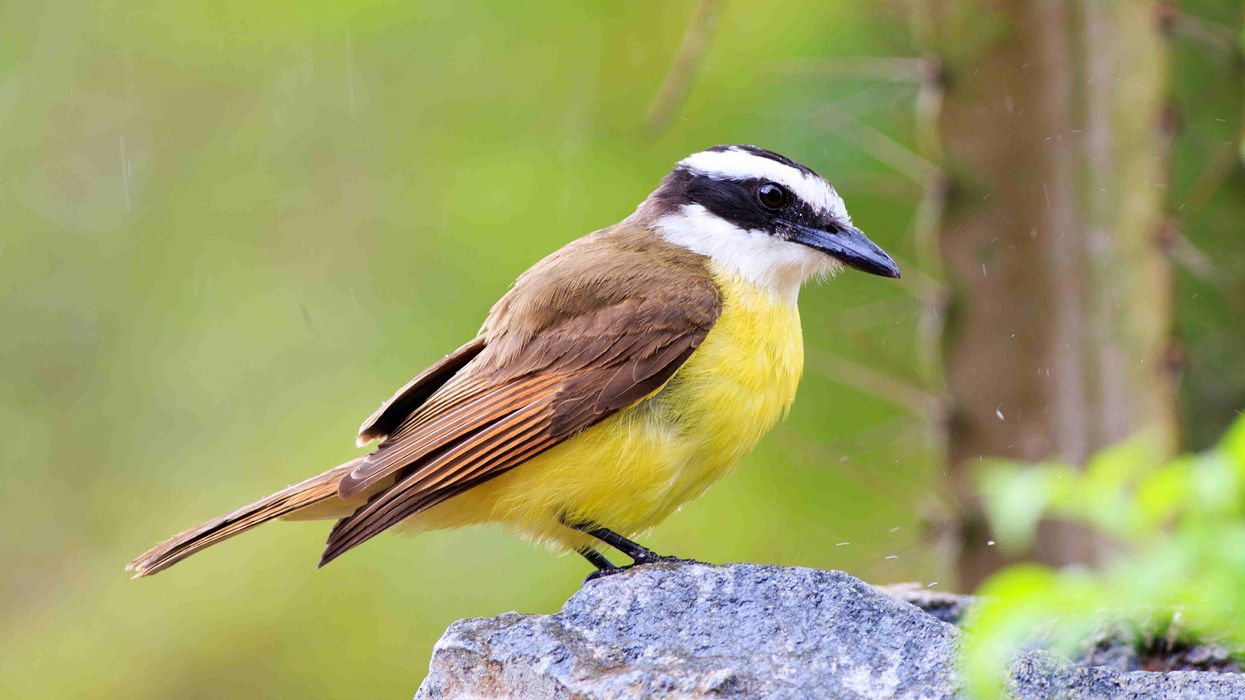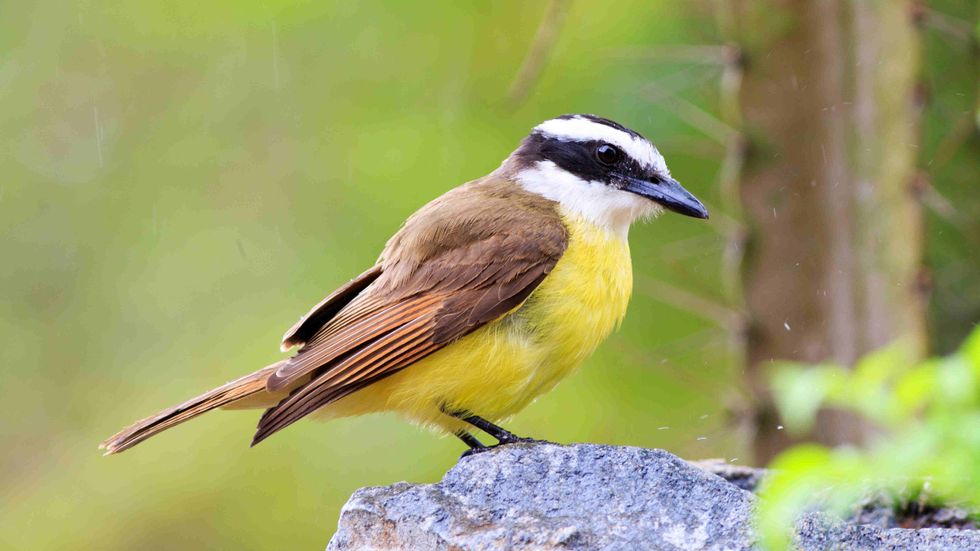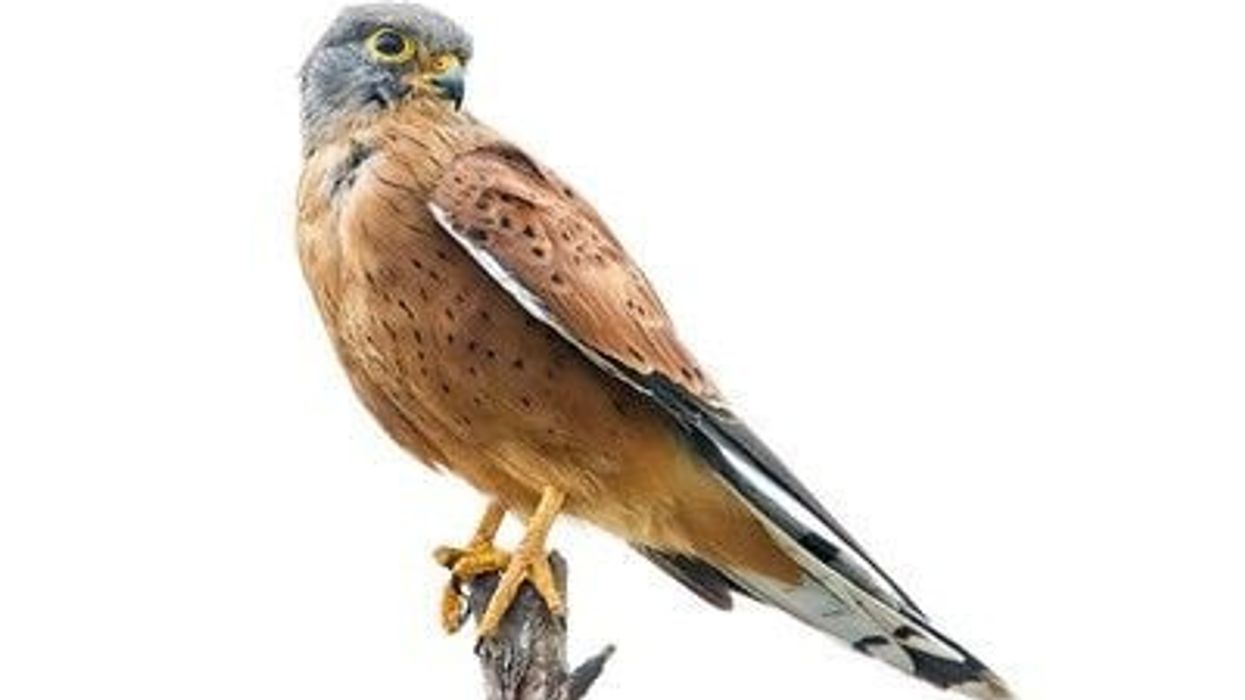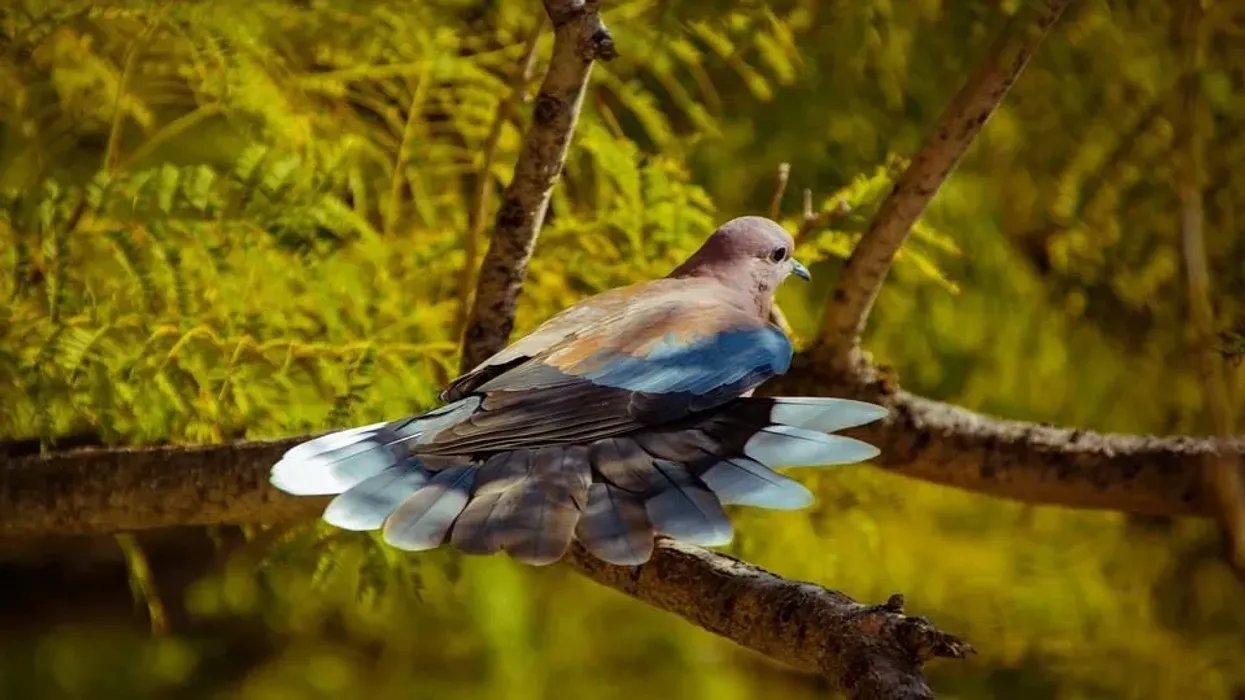Lesser kiskadee (Pitangus lictor) are small birds in the family Tyrannidae and are found in the northern part of South America. Lesser kiskadee are similar to the great kiskadee in looks but are a bit smaller in size.
The great kiskadee and lesser kiskadee were once considered the same species but recently have split and are now considered as two different species. The lesser kiskadee has a brown upper body and an olive-yellow lower body.
The head and neck parts are covered in black and white patches. They are mostly monogamous birds who mate from the month of March.
Females lay around 3-4 eggs, and both parents help in providing food to their young. Lesser kiskadee are wonderful birds of the world and, yes, beautiful too!
This was just the introduction. There are a lot of interesting and funny facts about this bird waiting for you below. So keep reading!
For more relevant content, read our flycatcher facts and vermilion flycatcher facts for kids.
Lesser Kiskadee Interesting Facts
What type of animal is a lesser kiskadee?
Lesser kiskadee (Pitangus lictor) are birds of the world found across the northern portion of South America in adequate numbers.
What class of animal does a lesser kiskadee belong to?
Lesser kiskadee belongs to the class Aves. It belongs to the order Passeriformes, family Tyrannidae and genus Philohydor. Their binomial nomenclature is Philohydor lictor (synonym Pitangus lictor). They are considered the only species in the genus Philohydor.
How many lesser kiskadee are there in the world?
Lesser kiskadee (Pitangus lictor) bird species are distributed across the northern part of South America in many countries. They are declared as species of Least Concern so counting their exact present population is not easily known.
Where does a lesser kiskadee live?
Lesser kiskadee (Pitangus lictor) birds can be found in the open woodlands and forest edges. They live in forests near rivers or streams. These bird species can be seen eating in the open near rivers and streams.
What is a lesser kiskadee's habitat?
Lesser kiskadee (Pitangus lictor) birds have their habitat range from the middle across the whole of north South American provinces. They are common to the countries like Argentina, Bermuda, Bolivia, Brazil, Colombia, Ecuador, French Guiana, Guyana, Panama, Peru, Suriname, Trinidad, Guatemala, and Venezuela.
Who do lesser kiskadee live with?
Lesser kiskadee (Pitangus lictor) birds are sometimes social and sometimes solitary. This bird species can be seen either alone or in pairs. Lesser kiskadee and social flycatchers are lookalike species.
How long does a lesser kiskadee live?
There is no proper information on exactly how long a lesser kiskadee (Pitangus lictor) lives. It is yet to be discovered.
How do they reproduce?
Social flycatcher lookalike lesser kiskadee (Pitangus lictor) are either seen alone or in pairs. They are monogamous bird species that stay together the whole year-round. They breed from the end of March and can be found in trees in pairs.
They breed near rivers, lakes, or even swamps. After mating, the female lays a clutch that has around three to four eggs in it.
Both parents feed their young and help them to grow. They nest at a moderate height from the ground with mainly leaves, twigs, hairs, moss, and wool. There are no information available on how long the egg takes to incubate.
What is their conservation status?
According to IUCN red list, social flycatcher lookalike lesser kiskadee (Pitangus lictor) birds are considered under the conservation status of Least Concern. They happen in adequate numbers in South American countries like Argentina, Bermuda, Bolivia, Brazil, Colombia, Ecuador, French Guiana, Guyana, Panama, Peru, Suriname, Trinidad, Guatemala, and Venezuela.
Lesser Kiskadee Fun Facts
What do lesser kiskadee look like?
Identification or spotting these birds in the open is easy. Lesser kiskadee (Pitangus lictor) are small and agile birds who live by flowing water bodies.
They are very similar to the great kiskadee species in case of looks but are smaller in size if compared to the great kiskadee birds. They have some amazing color patterns available on their small body.
They have a small found head and extremely cute wings. The tail is of medium size and has a small beak.
The colors mainly shown by them are olive-yellow, brown, black, and white. Their upper body is mostly brown in color and has streaks on it.
The lower body is olive-yellow colored and has no dark spots on it. The head and neck area are covered in black and white patches. The area near their eyes and the top of their head are black in color, while the other face portion and the throat area are completely white in color.
They are very similar to the social flycatchers also. They have legs mainly built for perching.
The legs and the feet are somewhat black in color. The beak, at the same time, is also black in color and has a sharp pointed tip.
As they are omnivorous bird species and feed on insects also, their beak plays the role of the prime weapon. The tail is of medium size, has long feathers, and is mainly brown-yellow-black colored.
They have brown eyes with a black pupil which looks very elegant. After their size identification, it has been estimated that they grow to a range of 5.9–7.1 in (15–18 cm), and their weight range varies around 0.9 oz (25 g).

How cute are they?
Lesser kiskadee (Pitangus lictor) are really cute and adorable bird species that are found in South American countries. They have vibrant colored birds who possess a clumsy nature. Seeing them in the wild is like a treat.
How do they communicate?
Lesser kiskadee (Pitangus lictor) are famous for their shrill 'kiskadee' call. They can be normally heard in woods, calling with a shrill voice.
How big is a lesser kiskadee?
Lesser kiskadee (Pitangus lictor) are small bird species from the order Passeriformes, family Tyrannidae. They are similar to birds such as the great kiskadee and social flycatcher.
Lesser kiskadee (Pitangus lictor) grow to a length range of 5.9–7.1 in (15–18 cm) and can weigh around 0.9 oz (25 g). They have a small round head and a beautiful set of wings. However, there is no information available on their wingspan range.
How fast can a lesser kiskadee fly?
There is no exact information on how fast lesser kiskadee (Pitangus lictor) can fly. But they are normally small birds who are agile in nature.
How much does a lesser kiskadee weigh?
Lesser kiskadee (Philohydor lictor) are small bird species that live in the tropical and subtropical shrublands in the north part of South America. These birds grow to a length of 5.9–7.1 in (15–18 cm) and can weigh around 0.9 oz (25 g).
What are the male and female names of the species?
There are no specific names assigned to the male or female lesser kiskadee (Philohydor lictor) bird species. They are commonly known as lesser kiskadee (Philohydor lictor). Both male and female birds have a similar size and color pattern.
What would you call a baby lesser kiskadee?
Like all baby birds, baby lesser kiskadee (Philohydor lictor) are also known as chicks or young ones.
What do they eat?
Lesser kiskadee (Philohydor lictor) are omnivorous bird species that eat both insects and fruits. They love feeding on insects such as grasshoppers, bees, moths, and beetles. At the same time, they also love eating berries, seeds, veggies, and nuts.
Are they dangerous?
Lesser kiskadee (Philohydor lictor) are dangerous for they prey for sure but are no threat to humans. These bird species are omnivores which feed on insects and their larvae but can hunt down small animals like frogs and mice also.
Would they make a good pet?
Lesser kiskadee (Philohydor lictor) are not that good pets. They are wild birds found mainly in South American countries like Argentina, Bermuda, Bolivia, Brazil, Colombia, Ecuador, French Guiana, Guyana, Panama, Peru, Suriname, Trinidad, and Guatemala. They enjoy being in the open and confining them into a limited space will surely create adverse effects on them.
Did you know...
Lesser kiskadee (Philohydor lictor) are endemic to the northern South American provinces.
There are two famous kiskadee species in the world, namely the great kiskadee and the lesser kiskadee.
What is the scientific name for kiskadee?
Lesser kiskadee birds belong to the family Tyrannidae and order Passeriformes. They belong to the genus Philohydor, and their scientific name is Philohydor lictor, also known as Pitangus lictor.
Do lesser kiskadee migrate?
Lesser kiskadee, like great kiskadee, are somewhat migratory in nature. They mostly roam around their feeding areas. Even if they migrate, they do it within their 'population distribution' range.
Here at Kidadl, we have carefully created lots of interesting family-friendly animal facts for everyone to discover! For more relatable content, check out these pigeon facts and owl facts for kids.
You can even occupy yourself at home by coloring in one of our free printable lesser kiskadee coloring pages.









